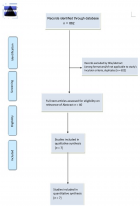About University of Tunis El Manar
University of Tunis El Manar
Articles by University of Tunis El Manar
An unmistakable tumour of the tongue
Published on: 11th November, 2022
A 37-year-old woman suffered from a painful and swelling lesion of the base of the tongue, with no history of smoking or medical history of tumours.
How to avoid partial implantation of people with cochlear malformation
Published on: 14th November, 2022
Many advances have been made in recent years in the development of hearing and cochlear implants. These use acoustic and electrical stimulation technologies to improve speech intelligibility for the hearing impaired. However, for cochlear prostheses, the results are not very promising and vary from one patient to another. Certain technical and sometimes physiological problems have limited the expected performances of these devices, especially for children and the elderly. These problems include cochlear malformation and ossification of the auditory channels. This led us to reduce the number of electrodes in order to allow quality deep insertion while preserving the low-frequency acoustic bands of the operated patient.
Primary follicular lymphoma arising from the ascendant colon: A case report
Published on: 24th January, 2023
Lymphomas are common hematological malignancies with an increasing incidence in recent years. The main site of extranodal non-Hodgkin’s lymphoma is the gastrointestinal tract, representing 40% of cases. The most common site of gastrointestinal lymphoma is the stomach, followed by the small intestine, accounting for 25% - 50% and 20% - 30%, respectively [1,2]. Primary colorectal lymphoma is a rare disease, accounting for 0.2% to 1% of all colorectal malignancies [1]. Males are more commonly affected with a peak incidence in the sixth and seventh decades of life [3]. Non-Hodgkin’s lymphoma is the most commonly described subtype of colonic lymphoma [1].
Non-operative management of perforated jejunal diverticulitis
Published on: 24th January, 2023
Diverticula can affect all segments of the gastrointestinal tract, from the esophagus to the colon. In order of decreasing, the jejunoileal location is the least frequent location [1] and has a prevalence of less than 2% of the population [2]. This location was first described by Sommering in 1794 [3]. More than two-thirds of small bowel diverticula occur in the jejunum. They appear mainly after the age of 60 with higher prevalence in males and rarely occur in patients under the age of 40 [4]. Jejunal diverticula are in general multiple and bigger than ileal ones [5]. Most of them are asymptomatic and do not require surgical treatment. Clinical presentations are diverse and not specific with no pathognomonic clinical symptoms.
Is binge watching among medical students associated with depression and anxiety?
Published on: 21st March, 2023
Objectives: Investigate binge-watching (BW) behavior among students and assess its correlation with anxiety and depressive symptoms. Methods: Medical students who met the definition of BW were divided, according to their viewing frequency, into three groups: G1: once a month or less, G2: once a week or once every two weeks, and G3: twice a week or more. Beck Depression Inventory and State-Trait Anxiety Inventory were used. Results: Ninety-four participants were recruited. The prevalence of BW was 72.3%. Depression and anxiety scores didn’t differ between binge watchers and the non-binge watcher group. G2 was found to be significantly less depressed (p = 0.014) and had a lower anxiety state (p = 0.05) and anxiety trait scores (p = 0.026) than the control group. Feeling tired was the most prevalent reason to stop viewing among G3 (p = 0.001). Conclusion: Binge-watching could be when used in a specific manner, a way to cope with negative feelings.
Effects of Zinc Supplementation on Oxidative Stress in Patients Undergoing Maintenance Hemodialysis
Published on: 20th October, 2023
Introduction: The aim of this study was to examine the effects of Zn supplementation on oxidative stress by evaluating changes in serum Copper (Cu) to Zinc (Zn) ratio, homocysteine (hCys), Glutathione (GSH), Total Bilirubin (TB) and Catalase (CAT) activity in hemodialysis patients.Methods: Seventy-seven HD patients were enrolled in a multicenter simple-blind randomized clinical trial. Only 37 HD patients completed the study. They were randomly divided into two groups and supplemented with zinc sulfate (n = 17) or placebo (n = 20) for two months. Serum Zn and Cu were measured by atomic absorption spectrophotometry. Serum hCys was measured by immunology method, serum GSH and CAT activity were assessed by spectrophotometry method and TB was measured by colorimetric method. Determinations were performed before and after supplementation.Findings: After zinc supplementation, serum Zn, serum GSH, and Serum Total Bilirubin (STB) significantly increased. Serum Cu to Zn ratio, serum hCys, and CAT activity significantly decreased in the Zn Zn-supplemented group.Conclusion: Zinc supplementation increased serum antioxidant factors such as Zn, GSH, and bilirubin and decreased serum oxidative factors such as copper to zinc ratio, hCys, and decreased CAT activity. The study results suggest that zinc supplementation may be a useful tool for the improvement of oxidative stress in HD patients.
Nitrogen supply effect on lettuce response to Botrytis cinerea and Sclerotinia minor
Published on: 6th November, 2023
Background information: Cultural practices play an important role on the development of pathogens (Datnoff, et al. 2007). In this context, several authors have been interested in studying the effects of mineral nutrition on the resistance of vegetables and fruits to fungi during storage, especially nitrogen.The purpose of the study: In this work we tested the effects of three contrasted regimes of nitrogen supply, with nitrate concentrations in the nutrient solutions of 2 mM (low), 10 mM (normal) and 20 mM (high) on the susceptibility of Lactuca sativa L towards Botrytis cinerea (BC87) and Sclerotinia minor (SM) during storage.Once harvested, the outerleaves of the plants derived from the three nitrogen regimes were inoculated with either Botrytis cinerea (BC87) or Sclerotinia minor (SM). Data showed that the resistance to this two pathogens increase when plants were developed under low nitrogen concentration. This resistance observed is correlated with low values in oxidative stress indicators (MDA and H2O2) and high values in total phenols.
A Rare Coexistence: Breast Cancer, Pheochromocytoma and Von Recklinghausen Disease
Published on: 11th December, 2023
Breast cancer associated with type-1 neurofibromatosis is a rare clinical entity. These patients have a higher risk of developing various types of cancers, especially tumors derived from the embryogenic neural crest, such as pheochromocytoma. This publication aims to add to the literature a rare association between Type-1 Neurofibromatosis, breast cancer, and pheochromocytoma.We present a rare case of a 51-year-old Tunisian woman with neurofibromatosis who was diagnosed with breast cancer and pheochromocytoma. The breast tumor was classified as T4b N1M0, and the discovery of the pheochromocytoma was incidental to thoracic-abdominal-pelvic CT. She underwent surgery to remove the adrenal gland and was referred to medical oncologists to receive chemotherapy for her breast cancer. Type-1 Neurofibromatosis disorder is a benign disease but can expose patients to numerous neoplasms. The challenging diagnosis at an early stage can worsen the prognosis and make medical care more difficult.
Pediatric Dysgerminoma: Unveiling a Rare Ovarian Tumor
Published on: 19th January, 2024
Background: Dysgerminomas, account for only 1% - 2% of all malignant ovarian neoplasms.Objective: This case report aims to present a rare occurrence of dysgerminoma in a pediatric patient, highlighting the clinical characteristics, diagnosis, and management.Case presentation: We present a case of dysgerminoma in a 12-year-old girl who presented with a three-week history of pelvic pain and progressive abdominal swelling. Physical examination revealed a distended abdomen with evident suprapubic fullness, and a palpable abdominopelvic mass measuring approximately 20 weeks in size. Imaging studies confirmed the presence of a solid heterogeneous mass originating from the pelvis. The patient underwent a right salpingo-oophorectomy without complications. Histological examination coupled with an immunohistochemical study confirmed the diagnosis of dysgerminoma. The patient had an uneventful postoperative course and was discharged without adjuvant treatment. Regular follow-up visits, physical examinations, ultrasound scans, and lactate dehydrogenase assays were initiated for monitoring. Conclusion: Prompt recognition and appropriate surgical intervention, followed by regular monitoring, are crucial for optimal outcomes in pediatric dysgerminoma cases.

HSPI: We're glad you're here. Please click "create a new Query" if you are a new visitor to our website and need further information from us.
If you are already a member of our network and need to keep track of any developments regarding a question you have already submitted, click "take me to my Query."
























































































































































